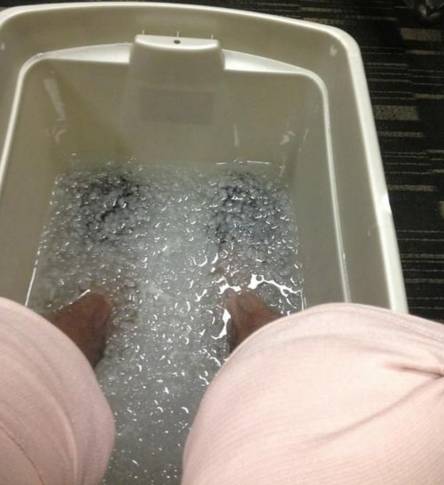Knee and patellar ligament sprains, light injury only ligaments, redness and heat pain symptoms are inevitable, many times, ice is the first first aid principle. Appropriate treatment can relieve pain and eliminate the effects of swelling. Because ice can slow down nerve conduction and reduce or relieve pain. It also reduces the permeability of the blood vessels, thereby reducing the leakage of local tissue fluid and reducing the swelling. What is cryotherapy? Ice, more systematically known as "Cryotherapy" is one of the most widely used methods of treating acute sports injuries. It's economical, convenient, yet effective, and is part of RICE technology to help reduce swelling and relieve pain. Ice can also be used to treat chronic injuries such as edema. What are the main effects of cryotherapy? For acute injuries, immediate use of cold therapy is a very important and effective method and is also very useful for long-term recovery of injuries. Its main effects are as follows: First, relieve pain At present, the mechanism for relieving pain after using ice is not very clear. There are many theories and hypotheses, and many mechanisms have been proposed to explain why ice packs can alleviate pain. These mechanisms include: l Ice application inhibits the transmission of pain nerve fiber signals; l hypothermia reduces the response of free nerve endings; l freezing reduces the pain threshold; l Low temperature freezing causes release of endorphins (which can relieve pain) in vivo; l Freezing conduction offsets pain transmission (according to the pain gate theory). Second, control bleeding and swelling By reducing the temperature of the skin and subcutaneous tissue, ice can shrink blood vessels, reducing blood infiltration into surrounding tissues, thereby reducing local swelling. After a few minutes of ice application, the contracted blood vessels reopen and restore local blood supply. This continually repeats the contraction of blood vessels and open blood supply, which we call "oscillatory response." Although the blood still flows to the injured area, the local swelling is significantly reduced after the application of ice. Swelling and edema are controlled, which increases muscle and joint mobility, reduces functional activity limitations, and facilitates early recovery. In addition, swelling caused by the inflammatory reaction causes an increase in localized pressure in the tissue, resulting in localized pain. This pain is mainly caused by the release of painful chemicals into the blood after local tissue damage. The use of ice can shrink blood vessels, reduce the painful substances into the blood, and also play a role in relieving pain. Third, relieve muscle cramps Muscle spasms are usually caused by pain. The surrounding muscles protect the damaged area (muscle defense) by contraction and prevent more serious damage. However, muscle cramps may aggravate pain or malfunction. Ice is very effective in relieving pain and helping to reduce muscle spasms. However, it is also believed that muscle spasm is not caused by acute injuries. More spasms occur in muscle overuse or imbalance. Ice can also be used to relieve this part of the muscle spasm. Its mechanism of action is not fully understood, mainly because ice can slow down the sensory and motor nerve conduction velocity, and also weaken the activity of muscle spindle cells (maintaining muscle tone), thereby reducing muscle spasm activity. Fourth, reduce the metabolic rate Low temperature can reduce the metabolic rate of cells and reduce the oxygen consumption of cells. When blood flow is reduced by vasoconstriction, the risk of hypoxic death (secondary cell death) in cells with reduced oxygen consumption is also reduced. How to implement cryotherapy Which method is chosen to be more effective depends on the location of the injury and the type of injury. Ice pack (bag): Ice packs are any kind of bag that can contain crushed ice. The easiest way to make an ice pack is to find a plastic bag, which can be a plastic bag, a towel or a specially designed ice bag. It is more effective in cold-sinking tissue than commercially available chemical or cryogel bags for longer periods of time. Put the ice in it and you're done. However, the self-made ice pack is also learned. Improper operation is likely to cause local tissue frostbite. Even in addition to frostbite, the homemade ice packs are too hard to match the contours of the human body, making the ice effect worse. When you accidentally get hurt and make your own ice pack, don't just put a bunch of small ice cubes in the bag. You should put some water in the ice while it is iced. This constitutes a mixture of ice and water. If necessary, apply an elastic bandage or a bandage to the injured area. The temperature is not frozen. Analytical from a physics perspective: for ice-water mixtures, its temperature is always zero. When the ice pack is placed on the skin to absorb heat, because of the ice, the heat is first absorbed by the ice, and during the process of melting the ice into water, the overall temperature of the ice-water mixture does not change (still zero). The overall temperature of the ice pack is not lower than zero, and the possibility of frostbite is greatly reduced. The cooling effect lasts for a long time and does not fluctuate too low, making it easy to obtain a relatively constant temperature state. The shape and skin are docile. The shape of the ice-water mixture can also be self-adhesive with the shape of the human body, and it also smoothly improves the defects that the pure ice ice pack cannot be shaped, and is especially suitable for some joint parts with uneven shape. Use immediately after injury. In practice, ice application is usually carried out immediately within 0 to 48 hours after the injury, and is continued intermittently and repeatedly. The time for using the ice pack is generally controlled at 10 to 20 minutes each time. This time intensity avoids the occurrence of possible frostbite and can obtain a satisfactory therapeutic effect. Some patients experience pain - slightly numb - a little stinging - the process of pain disappearing, which is where ice is applied. Ice bath: Ice baths are easier to make and fill half of the cold water or ice in a large container or tub. The size of the container and the depth of the water depend on the site of the injury to be treated. It is effective in treating areas with more localized bones, such as the feet, ankles, hands and elbows. After an acute injury, the injured area is immersed in an ice bath for treatment. However, ice baths are not as effective as ice packs and pressure belts because they do not act as a pressurizer (RICE technology). If the injured area is wrapped before the ice bath treatment, poor local conduction will also reduce the cold compress effect. Ice massage: Ice cubes can be used to massage the injured area . The ice cubes used for massage need special preparation. Usually, a small stick is added together to freeze them together, similar to a lollipop, so that the masseur can hold a small stick to prevent frostbite. Ice massage is mainly suitable for muscle damage and large area damage. When in use, hold the ice cube back and forth on the injured muscle. The shortcoming of this method is that the ice contact with the damaged place during massage is only temporary, and generally suitable for a lesser degree of damage. Moreover, when exposed to room temperature during massage, the frozen tissue is not sufficiently frozen. However, it is very effective for patients with local numbness, and rolling ice cubes can stimulate mechanoreceptors in the muscles. When the skin is damaged, the RICE technique is applied first. However, in order to prevent local bacterial infections, sometimes ice cubes can be added with appropriate antibacterial agents. In the preparation, you can mix distilled water, 10% iodophor and 2% lidocaine in a small plastic cup, then fix a small rod in the middle, expose the tail end, and freeze together to make antibacterial ice cubes. When you need to use it, hold the end of the stick and roll the ice cube back and forth on the skin for about 10 minutes, then regular treatment. How to apply ice? Use within the first 2-3 days of injury until the swelling subsides. However, if it is not used at the beginning or if the lesion is still swollen after 2-3 days of use, you can continue to apply ice. In use, you can wrap a towel or fabric around the ice pack, or use an elastic bandage to wrap the ice pack around the injured area. The ice is generally maintained for 15-20 minutes, then removed and returned to room temperature for about 20 minutes. Depending on the actual situation, you can choose to continue the ice, or you can do it every 2-3 hours. To avoid frostbite, do not place the ice pack directly on your skin. If the ice bag is placed directly on the skin for too long, it can cause frostbite, and the skin and subcutaneous tissue (muscle, nerves and fat) can be damaged, sometimes even permanent damage. In some parts, such as the elbow joint and the knee joint, the subcutaneous tissue is weak, the nerve is close to the skin, and it is necessary to control the time when the ice is applied, so as not to damage the nerve. After the operation of ice treatment, be careful not to let the condensate wet and contaminate the wound. What are the contraindications for using cryotherapy? First, there are contraindications to the use of ice or cryotherapy. In some cases, ice can not be used. 1. Raynaud's phenomenon (the phenomenon of necrosis of the arteries of the extremities): It is a disease involving the small blood vessels at the ends of the limbs causing necrosis of the purpura. If ice is used, exposure to cold conditions can exacerbate symptoms. 2, cold hypersensitivity reaction, mainly have the following performance: Ø Cold urticaria: As a kind of urticaria, after warming and then warming up, the body's histamine is released, causing skin flushing, itching and wheal. Ø Cold erythema: A red, itchy rash that is caused when exposed to cold conditions. Can cause severe pain and muscle cramps. 3. Cold hemoglobinuria: After being stimulated by cold, some red blood cells are destroyed, and hemoglobin in the cells is released into the blood to cause hemolysis. Free hemoglobin does not bind to proteins in the blood, causing dark red or soaked color urine. 4, sensory disorder: when there is local skin feeling numbness or decline, the patient can not perceive the pain and the degree of cold, cryotherapy is generally not used. Second, the following situations should be used with caution: 1, patients with heart disease: such as arrhythmia, angina pectoris, coronary heart disease. 2, hypertensive patients: vasoconstriction can cause blood pressure to rise. 3, superficial nerve: ice should not be placed near the nerves of the epidermis. 4. Wounds in healing: Ice should not be used on newly wounds that have not healed. Stainless Steel Water Bucket,Stainless Steel Water Pail,Stainless Water Bucket,Flat Sided Water Bucket Jiangmen Junerte Stainless Steel Kitchenware Co.,Ltd , https://www.jmjetkitchenware.com
